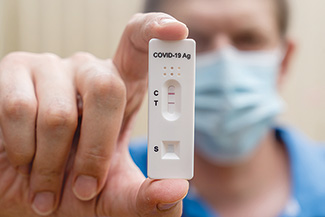What if COVID-19 comes back?
 The number of people are getting COVID-19 twice, three times, even four times, is growing. So, how risky are repeat infections?
The number of people are getting COVID-19 twice, three times, even four times, is growing. So, how risky are repeat infections?
Since the start of the pandemic, almost everyone in the United States has had COVID-19, whether they know it or not. The Institute for Health Metrics and Evaluation estimates that 95 percent of Americans were infected at least once by the end of August 2022.
It’s becoming less unusual to have COVID-19 more than once. And now the number of people experiencing COVID-19 for a second or third time is growing. Hugh Jackman, Drake, Kourtney Kardashian and Jimmy Kimmel are just a few of the many who have contracted the virus twice.
HOW COMMON ARE COVID-19 REINFECTIONS?
While the Centers for Disease Control and Prevention (CDC) is still collecting and analyzing data on reinfections, some states have presented figures that give some idea of the scope of the issue.
A report issued by the state of New York suggests that just over six percent of total cases were reinfections. At the end of September, the Department of Health in Hawaii reported that the percentage of COVID-19 cases involving individuals who had a prior infection has grown to about 10 percent of new confirmed cases.
“The data on reinfections underscores what we have been saying; that limited immunity from previous infection only lasts so long. Regardless of whether a person has had COVID-19 in the past, they should stay up to date on their vaccinations and boosters to get increased protection from severe illness and hospitalization,” said Hawaii State Epidemiologist Sarah Kemble, M.D.
SUBVARIANTS CAUSING REINFECTIONS
Since COVID-19 first appeared around three years ago, the virus has been evolving. Omicron has proven to be an efficient spreader of the disease, with the BA.5 and BA.4 subvariants especially good at evading protection provided by vaccines and previous infection.
“The bad news is these omicron subvariants are causing the majority of reinfections,” says Dean Winslow, M.D, professor of medicine at Stanford University in California. But the good news is, it does appear that the omicron variants are less virulent — meaning they are less likely to cause severe disease — than the original Wuhan strain or the delta variant.
Back in late 2021 and early 2022, as omicron took over from the delta variant, it became clear that existing vaccines were less effective than they had been at keeping people from getting infected. Although boosters initially bumped up protection against all infections, a CDC study published in 2022 discovered that their ability to ward off mild or moderate illness began to wane after four months.
CAN THE UPDATED BIVALENT BOOSTERS HELP?
When omicron came on the scene late last year, readily infecting even immunized people, federal health officials urged vaccine makers to retool their shots and come up with a formula that would target this new variant. By Sept. 1, both the U.S. Food and Drug Administration and the CDC had green-lighted updated boosters from Pfizer and Moderna. The new bivalent boosters target BA.4 and BA.5 by including components of the virus’s so-called spike protein to the existing vaccine composition.
“The updated COVID-19 boosters are formulated to better protect against the most recently circulating COVID-19 variant. They can help restore protection that has waned since previous vaccination and were designed to provide broader protection against newer variants,” said Rochelle Walensky, M.D., MPH, director of the CDC.
Preliminary evidence suggests that the bivalent vaccines offer more powerful protection than earlier formulations. Infectious disease experts say it’s still too early to predict how well the boosters will perform in the real world.
REINFECTION GOOD OR BAD?
The CDC says that people who recover from COVID-19 retain antibodies that offer some protection against reinfection. But the consequences of repeat infections may lead to unexpected health troubles down the road. A preliminary study from Washington University in St. Louis looked at the health records of more than 5.4 million Veterans Administration patients. The researchers found that those who had COVID-19 more than once had double the odds of having or dying from a heart attack compared with those who’d had COVID-19 just once. Lung, kidney and gastrointestinal health risks were also greater among the reinfected.
New COVID variant JN.1 surges to 44% of cases
The new COVID-19 variant that scientists call JN.1 now makes up about 44.1% of COVID-19 cases across the country, the Centers for Disease Control and Prevention estimated on Dec. 23, marking another week of the fast-spreading variant’s steep rise in the U.S.
The increase is more than two times larger than the 21.3% that the CDC now estimates the strain made up of infections for the week ending Dec. 9, after Thanksgiving.



Leave a Reply